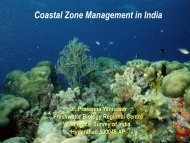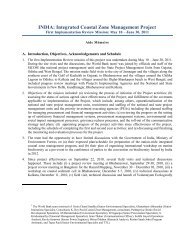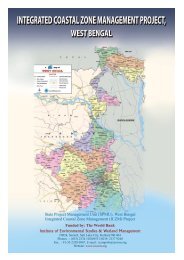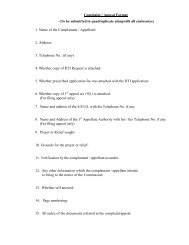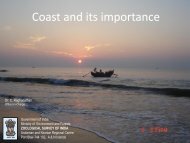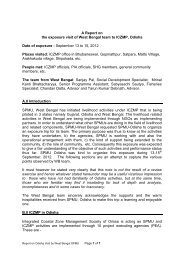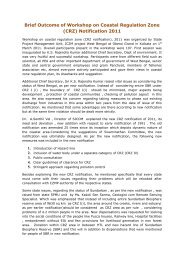Cyclone and Storm Surge - Iczmpwb.org
Cyclone and Storm Surge - Iczmpwb.org
Cyclone and Storm Surge - Iczmpwb.org
You also want an ePaper? Increase the reach of your titles
YUMPU automatically turns print PDFs into web optimized ePapers that Google loves.
5.2<br />
particular human settlement to a particular hazard should address its level of vulnerability with<br />
respect to each of the following aspect:<br />
a) Housing Stock<br />
b) Local economy<br />
c) Physical <strong>and</strong> Social Infrastructure<br />
d) Incidence of loss on various socio-economic groups<br />
e) Human Mortality <strong>and</strong> Morbidity<br />
The ‘Degree of Vulnerability’ of any system or its components can only be assessed through<br />
contemplating its performance under hypothetical hazard scenario with varying intensity. The study<br />
area lies within the Very High Damage Risk Zone delineated by the Vulnerability Atlas prepared by<br />
BMTPC, indicating that Average Recurrence Interval (ARI) of 50 years for wind gusts having speed<br />
more than 198 kmph (at the height of 10 m from the surface for more than 3 seconds). It also<br />
indicates same ARI for storm surge height coupled with tidal fluctuation of 12.5 m height on the South<br />
24-parganas coast <strong>and</strong> 12.0 m height on the East Midnapore coast. For the vulnerability assessment<br />
this hypothetical hazard scenario has been adopted, however, in some blocks, the level of hazard is<br />
expected to be far worse than this assumed intensity <strong>and</strong> periodicity.<br />
In the following sections, each aspect of vulnerability will be discussed along with comparative<br />
assessment at CD block level for the coastal districts of West Bengal.<br />
5.2. Assessment of Housing Stock<br />
Damage done to the human shelter is one of the most significant consequences of tropical cyclone.<br />
The wind pressures <strong>and</strong> suction effect on housing structures due to high velocity of wind can be<br />
sufficient to lift them off <strong>and</strong> fly away – known as aerofoil effects. The main destruction due to high<br />
wind velocities occurs in the traditional non-engineered buildings using local clay, adobe or agrobased<br />
materials. The engineered buildings also suffer huge damage unless appropriate precautions<br />
are taken into consideration during building construction. Apart from these, substantial non-structural<br />
damage occurs to doors <strong>and</strong> windows, cladding, wall panels etc in heavy engineered construct due<br />
to wind gust.<br />
On the other h<strong>and</strong>, tropical cyclones are always accompanied with heavy precipitation resulting in<br />
huge surface run-off from the catchment basin to the drainage channels. Combined with the storm<br />
surge these results in inundation <strong>and</strong> flooding. Damage to the housing stock depends on the water







